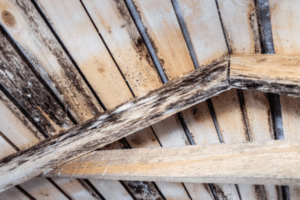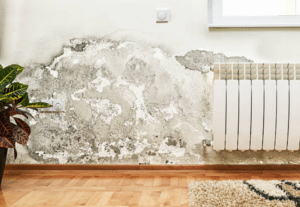Mould is a common nuisance for tenants across the UK.
Prolonged exposure to mould spores can cause serious health problems including asthma, respiratory infections, rashes, and allergic reactions.
That’s why it’s vital for renters to take action when mould appears in their home.
However, getting landlords to properly address mould issues can often feel like an impossible task.
This guide will walk you through the key steps tenants should take, from writing an initial letter to their landlord, all the way up to pursuing legal action if necessary.
Acting quickly and firmly is crucial to protecting your health and your rights as a tenant.
If you want to understand your rights as a tenant when it comes to mould in you rented property, have a read of our blog ‘Tenants Rights Mould UK‘.
Identifying Mould
Mould can look fuzzy or slimy and come in colours like grey, green, brown, black or white.
It thrives in damp areas with poor ventilation.
Check spots like window frames, walls, ceilings, bathrooms, and under sinks where moisture builds up.
Take photos and make notes on when you first noticed the mould.
This documentation will be helpful if you need to escalate the issue with your landlord.
Exposure to mould spores can lead to respiratory problems, allergic reactions, headaches, and long-term health issues.
So take any mould growth in your rental seriously.
First Steps for Tenants
At the first sign of mould, start keeping detailed records, including dated photos documenting the problem.
Also note any verbal and written communication with your landlord.
Your initial requests to your landlord about mould issues should be made in writing via email/letter.
Politely point out the issue, the health risks, and ask them to send a professional to inspect and remove the mould properly.
Follow up if you get no reply after 7 days.
If they still don’t respond, you’ll need to send a formal letter.
Writing a Formal Letter
A formal, dated letter sent by recorded delivery puts your landlord on notice that you are serious about fixing the mould problem.
The letter should identify the mould, note your previous contact attempts, and clearly ask for professional inspection/removal.
Refer to their duties under the Landlord and Tenant Act 1985 to maintain the property hazard-free.
Request a response within 14 days and say you’ll get the council involved if it’s not addressed properly.
See the sample letter at the end of the article for a template you can tailor to your situation.
Landlord’s Legal Responsibilities
Landlords have clear legal duties under the Landlord and Tenant Act 1985 to ensure their properties are free of serious hazards including mould.
If they fail to act, they can face civil and criminal penalties.
Local councils enforce these responsibilities through their Environmental Health Departments.
When made aware of unresolved issues, they can inspect properties and order repairs or improvements.
Contacting the Council
If your landlord hasn’t adequately addressed a mould issue within 14 days of your formal notice, your next step is to contact your council’s Environmental Health Department.
The council can send an officer to assess your unit using the Housing Health and Safety Rating System (HHSRS).
Mould and damp are considered Category 1 hazards.
If found, the council can serve the landlord an Improvement Notice giving timescales for fixing the problem.
Failure to comply can lead to fines.
Taking Legal Action
If the landlord still refuses to fix a serious mould issue despite council intervention, you may need to pursue legal action through the courts.
You can apply for an order requiring the landlord to do repairs or seek compensation.
It’s advisable to get legal advice on your options.
Going to court should always be a last resort.
But it can become necessary to enforce your rights if your landlord simply ignores their duties on mould and your health is at risk.
Conclusion
Dealing with mould in rentals can be frustrating.
But tenants have clear rights under the law.
Following the proactive steps in this guide, from record keeping to formal notice, council involvement, and legal action if needed, can ensure your landlord takes responsibility for providing a mould-free, healthy home.
Don’t wait – act quickly if you spot mould.
Resources
Citizens Advice Bureau – Offers tenants housing advice and rights info
Shelter – Charity providing housing advice and legal services
Tenant’s Voice – Advocacy group supporting tenant’s rights
Mould Removal London – Get a professional inspection and quote (0203 130 4068)
Sample Formal Notice Letter
[Date]
[Landlord’s name and address]
Re: Mould at [property address]
Dear [Landlord’s name],
I am writing about the ongoing mould problem at the property. As detailed in my previous messages on [dates], there is persistent mould growth in [locations].
Despite contacting you about this serious issue multiple times over the past [period] without resolution, the mould poses significant health risks including respiratory illness. You have a legal duty as my landlord to maintain the property hazard-free.
I ask that you send a professional mould inspector within 7 days and subsequently have the mould removed properly. If I don’t receive confirmation an inspection is booked within 7 days, I will escalate this to the council’s Environmental Health Department.
Under the Housing Health and Safety Rating System, the Environmental Health Department can order you to do required repairs or improvements if the property is deemed hazardous.
I look forward to your prompt action to successfully resolve this issue. Please confirm your plans for inspection and mould removal in writing within 7 days. If the mould is not adequately addressed within 14 days, I reserve the right to pursue further legal action.
Thank you for your cooperation.
Yours sincerely,
[Tenant’s name and signature]



